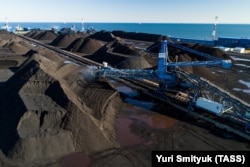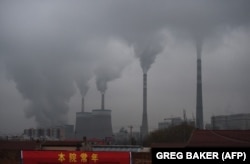Blackouts in Tajikistan, energy shortages in Ukraine, rising electricity costs across the Balkans, and short-term profits for state companies in Russia.
Those are some of the early ripple effects being felt across Eurasia from an accelerating global energy crisis caused by fuel shortages for power generation inside China and soaring prices across Europe that are affecting consumers and producers alike.
The deepening crisis taking hold across Europe and Asia also risks imperiling the global economy as it attempts to recover from the slowdown due to the coronavirus pandemic.
With winter approaching, the sudden energy crunch hitting the world is threatening already stressed supply chains, stirring geopolitical tensions, and raising questions about how ready the world is for a transition to greener forms of energy.
“The global energy price rally has affected economies all over the world, as the prices of oil, coal, and gas have risen,” Jack Sharples, an expert at the Oxford Institute for Energy Studies, told RFE/RL. “Furthermore, the energy crisis has exposed the inelasticity of our energy demand: Even with high prices, we keep consuming hydrocarbons because we have no readily available alternative.”
Chinese imports of coal from Russia have tripled compared to last year. The rising cost of natural gas has also given Moscow and Gazprom, its state-run gas company, additional leverage over Brussels as it pushes for final approvals for its new and controversial Baltic Sea gas pipeline to Germany, Nord Stream 2, which will bypass Ukraine.
China’s energy-producing neighbors, like Kazakhstan and Turkmenistan, have also seen a rise in demand for coal and gas, respectively, although those shipments have been slowed by logistical and production limits in delivering larger than planned quantities to China.
Elsewhere, North Macedonia’s government has held emergency meetings to address the unfolding crisis, announcing temporary funds to boost energy companies and introducing caps on electricity use for businesses.
Inside the European Union, disagreements over how to respond to the crisis are emerging, with some leaders asking the bloc for assistance and others -- like Hungarian Prime Minister Viktor Orban -- blaming the price hikes on the EU’s sweeping policies to combat climate change and reduce emissions.
“This energy crisis could affect how Brussels implements its flagship Green Deal climate policies, particularly the expansion of the EU’s emissions trading system,” Charles Dunst, an associate at Eurasia Group's Global Macro team, told RFE/RL. “The plans were already unpopular and the energy crisis is likely to [make any] support dwindle [even further] in the coming months.”
Origins Of An Energy Crisis
The current energy crunch first emerged in China, the world’s top manufacturer, as global demand for its products suddenly and unexpectedly shot upward this year as part of a post-pandemic economic surge.
Due to an unofficial Chinese ban on Australian coal, which had previously been the country’s top supplier, coal stocks were low. China’s electricity deficit was also added to by conflicting climate policies adopted within the country.
Chinese President Xi Jinping pledged that China would be carbon-neutral by 2060, leaving regional governments in China scrambling to bring emissions of carbon dioxide and other greenhouse gases in line with the set limits. As a result, factories were left dealing with electricity rationing and power cuts.
With coal supplies dwindling at home, Chinese power companies also turned to the natural-gas market, leading to purchases at an even faster rate than traders in Europe had been anticipating and causing prices to soar.
“The energy crisis has disrupted production in China, which risks further slowing global supply chains ahead of the West’s busy Christmas shopping season and beyond,” Dunst said.
Natural-gas prices have since hit a series of record highs.
In Europe, the prospect of supply shortages is growing as demand is also rising across Asia, where buyers have been prepared to keep paying a premium and outbid their European counterparts.
That disparity is likely to intensify after China ordered state-backed companies in October to secure energy supplies no matter the cost. Since then, imports of coal and gas have continued to grow.
The move by China suggests that other parts of the world will face an even tougher time securing the fuel they need, Dunst said.
Crisis And Opportunity
Amid the flux in the global energy market, Russian President Vladimir Putin has moved to leverage his country’s vast energy reserves.
During the pandemic, overall gas exports to the EU from Russia -- which supplies about 50 percent of the bloc’s imports -- fell because there was less demand as economic activity shrank. Although it has picked up again in Europe, this downward trend has been continuing, with lower supplies this year. This has led to European stocks being depleted, which in turn is driving up prices.
Putin and Russian officials have urged Germany to speed up its regulatory approval of Nord Stream 2, suggesting that it would provide a long-term solution to the country’s energy problems.
Meanwhile, on Russia’s eastern front, energy companies have moved quickly to meet China’s growing demands, supplying three times as much coal this year to the country as during 2020, according to Chinese customs data.
“The current two-front energy crisis presents a short-term window of opportunity for Moscow to push for the realization of its energy projects in Europe under sanctions and to strengthen its position as energy supplier to China,” Vita Spivak, an analyst at the consulting firm Control Risks, told RFE/RL. “While the current crises appear to be mostly the result of post-coronavirus economic development, energy shortages might present themselves in the future as the world is trying to embark upon the ‘green transition.’”
Moscow has pivoted to supply China’s evolving energy needs with oil and gas accounting for more than 60 percent of Russian exports to China, a trend that could continue as China weans itself off coal and relies more on gas.
The Power of Siberia pipeline launched in 2019 already provides gas to China, with plans for its output to increase in the future. A second pipeline, Power of Siberia 2, is also under discussion.
In the meantime, Russia continues to have its attention on coal.
Moscow announced it would temporarily halt coal shipments to Ukraine starting on November 1, saying that it was needed for domestic consumption, despite increasing its exports to other countries.
Further down the line, Russia is also looking at how to ramp up its coal supplies to China and is currently investing $10 billion into railroad infrastructure in its Far East in order to meet future Chinese needs before the country progresses on its transition to alternative energy sources.
“In order to leverage its position, Moscow has to ensure the relevant energy export infrastructure is in place, which presents a challenge within this window of opportunity,” said Spivak. “Moscow realizes that the window of opportunity to sell its hydrocarbons to Europe and China is limited.”











